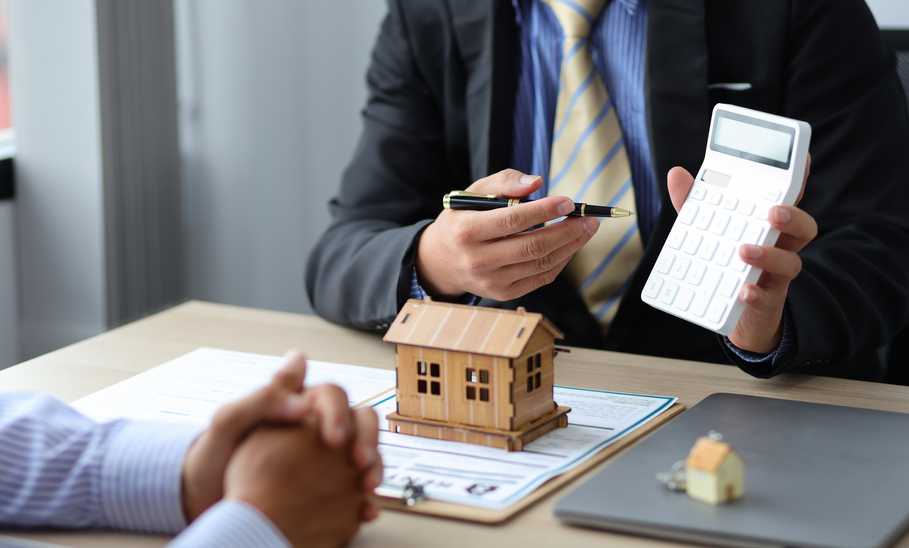What Is the Average Down Payment on a House in 2024?

Our evaluations and opinions are not influenced by our advertising relationships, but we may earn a commission from our partners’ links. This content is created by TIME Stamped, under TIME’s direction and produced in accordance with TIME’s editorial guidelines and overseen by TIME’s editorial staff. Learn more about it.
Saving up a big enough down payment to purchase a home is hard enough, but things only get worse when housing prices continue climbing year after year. Unfortunately, that's the exact situation homebuyers of all age groups are in right now.
In fact, National Association of Realtors (NAR) figures show that the median sales price for existing homes came in at $266,300 in January of 2020 before climbing up to $359,000 in January 2023. Ultimately, this means someone trying to save up a 5% down payment would have needed $13,315 for the average home in January of 2020 but $17,950 just three years later.
And that's just for people trying to save up a 5% down payment, which is a little less than the average down payment most people come up with. The NAR points out that the average first-time home buyer has made an average down payment of 6% to 7% since 2018. For repeat buyers, however, the average home down payment was around 17% last year.
While the average down payment amounts are worth exploring, you may also want to note the minimum down payment required for different types of home loans. Keep in mind that this is the minimum amount you'll need to come up with if you want to buy a home and move when money is tight.
The chart below shows the minimum down payment required for various types of mortgages:
| Mortgage type | Minimum down payment | Limitations |
|---|---|---|
Adjustable-rate mortgage (ARM) | 5% | These loans offer a temporary teaser rate followed by a variable interest rate that fluctuates based on market conditions |
Jumbo loan | 10% | Higher credit score and cash reserve requirements often apply with these loans |
Conventional mortgage | 3% to 5% | Conforming loan limits apply, which are set at $726,200 in most parts of the U.S, in 2023 |
VA loan | 0% | Eligible military service required |
USDA loan | 0% | These loans require homes to reside in areas deemed "rural" by the United States Department of Agriculture (USDA) |
FHA loan | 3.5% if your credit score is 580 or above | If your credit score is 500 to 580, you'll need a down payment of 10% |
An adjustable-rate mortgage (ARM) is a type of home loan that starts you off with a lower fixed interest rate for a set number of years, after which a variable rate that changes based on market conditions applies. These loans typically require a minimum down payment of at least 5%, although your exact down payment requirement can depend on the home price, your credit score, income, debt-to-income ratio and other factors.
Common mortgage types that fall into this home loan category include the 5/1 ARM, the 7/1 ARM and the 10/1 ARM.
A jumbo loan is a mortgage in an amount that exceeds conforming loan limits. This limit is set at $726,200 in 2023 across most of the United States, although some higher cost parts of the country have a higher limit of $1,089,300.
The minimum down payment requirement for jumbo loans is typically set at 10% or higher.
According to the Consumer Financial Protection Bureau (CFPB), a conventional mortgage is any type of home loan that is not part of a government program. Conventional mortgages can be conforming or non-conforming.
FHA loans typically require a minimum down payment of 3.5%, although you may need a down payment of at least 10% if your credit score is between 500 and 579. These loans come with competitive rates and terms, yet they are only available for the purchase of a home you plan to live in.
A VA home loan is available for eligible military service members and veterans. This type of home loan comes with easier credit requirements and no required down payment at all, plus low closing costs and competitive rates and terms. These loans are only for a primary residence.
USDA home loans are only for homes deemed "rural" by the United States Department of Agriculture (USDA). This type of home loan comes with no requirement for a down payment, plus competitive rates and terms for eligible homebuyers. However, your household income cannot exceed 115% of median household income to be eligible for this type of loan, so not everyone can qualify.
While this probably won't surprise you too much, the median down payment for a home tends to increase dramatically as homebuyers age. This is likely due to a range of factors, including the fact older homebuyers may be closer to their peak earning years, and that they often have built-up home equity from other homes to roll into their new purchase.
The National Association of REALTORS® Research Group has some of the best and most accurate figures on this data, although they focus only on the percentage of the down payment and not on the loan amount or any other loan features.
Based on their data, the median down payment amount for all homebuyers came in at 13%, whereas the youngest buyers (ages 23 to 31) put down a median amount of 8% and homebuyers ages 76 to 96 put down a median percentage of 30% of the purchase price.
All other age ranges in between put down amounts somewhere within that range, as you can see in the chart below:
| Age group | 23 to 31 | 32 to 41 | 42 to 56 | 57 to 66 | 67 to 75 | 76 to 96 |
|---|---|---|---|---|---|---|
Median down payment | 8% | 10% | 15% | 21% | 28% | 30% |
The average down payment for a home varies quite a bit depending on the state you live in, which makes sense when you consider how widely housing prices vary nationwide. To come up with an average down payment amount for housing in each state across the United States, we used the national average down payment amount of 17% for repeat buyers and applied it to the average sales price for homes sold using Redfin data from February of 2023.
As you'll see in the chart below, California had the highest average down payment of $120,020 earlier this year, while residents of Iowa had the lowest average down payment of $34,357.
| State | Average Home Price (February 2023) | Average Down Payment at 17% |
|---|---|---|
Alabama | $261,600 | $44,472 |
Alaska | $358,900 | $61,013 |
Arizona | $407,700 | $69,309 |
Arkansas | $256,300 | $43,571 |
California | $706,000 | $120,020 |
Colorado | $545,800 | $92,786 |
Connecticut | $332,100 | $56,457 |
Delaware | $300,000 | $51,000 |
Florida | $389,700 | $66,249 |
Georgia | $347,900 | $59,143 |
Hawaii | $670,800 | $114,036 |
Idaho | $441,400 | $75,038 |
Illinois | $238,600 | $40,562 |
Indiana | $231,900 | $39,423 |
Iowa | $202,100 | $34,357 |
Kansas | $236,800 | $40,256 |
Kentucky | $233,600 | $39,712 |
Louisiana | $243,700 | $41,429 |
Maine | $335,000 | $56,950 |
Maryland | $376,400 | $63,988 |
Massachusetts | $523,600 | $90,542 |
Michigan | $216,000 | $36,720 |
Minnesota | $315,000 | $53,550 |
Mississippi | $257,900 | $43,843 |
Missouri | $226,500 | $38,505 |
Montana | $420,572 | $71,497 |
Nebraska | $265,400 | $45,118 |
Nevada | $406,500 | $69,105 |
New Hampshire | $397,200 | $67,524 |
New Jersey | $419,600 | $71,332 |
New Mexico | $350,700 | $59,619 |
New York | $484,600 | $82,382 |
North Carolina | $340,300 | $57,851 |
North Dakota | $235,975 | $40,116 |
Ohio | $210,000 | $35,700 |
Oklahoma | $229,800 | $39,066 |
Oregon | $480,900 | $81,753 |
Pennsylvania | $244,100 | $41,497 |
Rhode Island | $394,900 | $67,133 |
South Carolina | $342,500 | $58,225 |
South Dakota | $293,200 | $49,844 |
Tennessee | $353,000 | $60,010 |
Texas | $336,000 | $57,120 |
Utah | $505,200 | $85,884 |
Vermont | $338,700 | $57,579 |
Virginia | $390,900 | $66,453 |
Washington | $572,400 | $97,308 |
West Virginia | $284,500 | $48,365 |
Wisconsin | $264,000 | $44,880 |
Wyoming | $256,000 | $43,520 |
As we noted above already, the minimum down payment requirements for a home can vary based on the type of home loan you've picked, your credit score, and other factors. As an example, a conventional mortgage typically requires a down payment of 3% to 5%, whereas you may need to put down 10% or more of the purchase price if you need to take out a jumbo mortgage with a larger-than-normal loan amount.
Meanwhile, USDA loans and VA loans for eligible buyers have no down payment requirement.
There are many schools of thought when it comes to finding the right down payment for a home, although you'll definitely be able to access more loan options when your down payment is higher than average. Here's a breakdown of reasons to consider a down payment from 3% to 20%.
With at least 3% of the purchase price of the home you want to purchase stashed away, it's possible you'll have enough to qualify for a conventional mortgage with competitive rates and terms.
With at least 5% to put down, you'll be able to qualify for a conventional mortgage if you meet other requirements and criteria, including having a minimum credit score of 620. You can also qualify for a FHA loan with just 3.5% down if you meet eligibility requirements and your credit score is at least 580.
A 10% down payment is enough to qualify for a jumbo loan if all other borrowing criteria are met. This type of home loan is for larger loan amounts that exceed conforming loan limits, and you may also need to meet higher credit and cash reserves requirements to be eligible.
Saving up at least 20% to put down on a home can help you qualify for a conventional mortgage without the added cost of private mortgage insurance (PMI). This down payment threshold can also help you qualify for the best mortgage rates, which can lead to long-term interest savings as you pay off your home loan.
If you're thinking of shopping for a home in a specific price range, the table below shows what your down payment would be at 3% down to 20% down.
| Home purchase price | 3% down payment | 5% down payment | 10% down payment | 20% down payment |
|---|---|---|---|---|
$150,000 | $4,500 | $7,500 | $15,000 | $30,000 |
$200,000 | $6,000 | $10,000 | $20,000 | $40,000 |
$250,000 | $7,500 | $12,500 | $25,000 | $50,000 |
$300,000 | $9,000 | $15,000 | $30,000 | $60,000 |
$350,000 | $10,500 | $17,500 | $35,000 | $70,000 |
$400,000 | $12,000 | $20,000 | $40,000 | $80,000 |
$450,000 | $13,500 | $22,500 | $45,000 | $90,000 |
$500,000 | $15,000 | $25,000 | $50,000 | $100,000 |
$750,000 | $22,500 | $37,500 | $75,000 | $150,000 |
$1,000,000 | $30,000 | $50,000 | $100,000 | $200,000 |
Common wisdom says you'll want to save up at least 20% of the purchase price of a home before you start shopping around. However, saving up this much cash is becoming much more difficult as housing prices rise.
Consider the pros and cons of saving up 20% before you make this important decision:
While saving up a down payment is a crucial part of the homebuying process, you'll want to make sure you consider other costs as well. For example, the CFPB says you'll want to set aside some cash to cover closing costs for your mortgage and home purchase, which could be substantial.
The organization estimates that closing costs can tack on another 2% to 5% of the sales price of a home, or $6,000 to $15,000 in closing costs for a home worth $300,000. Make sure you have this cash set aside, or else you'll have to pull it from the down payment amount you save up.
You'll also want to factor in moving costs, particularly if you're moving a long distance or you require the help of a moving company. Finally, make sure you have an emergency fund with cash you can use for unexpected expenses that might pop up. Most experts suggest having three to six months of expenses stashed away in a savings account you can access if you need to.
You'll want to keep these funds and your growing down payment amount in a high-yield savings account so you can earn interest on your cash with the goal of keeping up with inflation. Consider a Capital One 360 savings account since these accounts come with competitive interest rates and no hidden fees.
USDA loans and VA loans don't require you to put down a specific amount or anything at all, although these loans are geared to a distinct segment of buyers and not everyone can qualify. That said, it may be possible to qualify for a conventional home loan with as little as 3% down, and FHA home loans are available with a minimum down payment of 3.5%.
If you can't afford the down payment on a home you want, you may want to continue saving until you build up your savings enough to qualify. If you have at least 3% or 3.5% to put down, however, you may be able to qualify for a conventional mortgage or a FHA loan.
If the home you want to buy is located in an eligible rural area, you can also look into USDA loans that don't require a down payment.
Reach out to a mortgage company in your area to get an idea of what you need to save up to become eligible for a home loan. If you don't feel comfortable talking with a mortgage professional quite yet, you can also strive to save up at least 3% to 5% of the purchase price of homes you want to buy and reach out at that time.
If you want to start saving up for a home down payment, you'll want to open one of the best savings accounts available today. That way, you'll earn interest on your deposits and keep your down payment separate from other savings you have.
You can also speed up the saving process by setting up automatic money transfers on certain days of the month (e.g. on payday twice per month). Also consider adding "found money" to your down payment savings account, including cash you get for a birthday or wedding, your tax refund and other money you come across.
The information presented here is created by TIME Stamped and overseen by TIME editorial staff. To learn more, see our About Us page.



